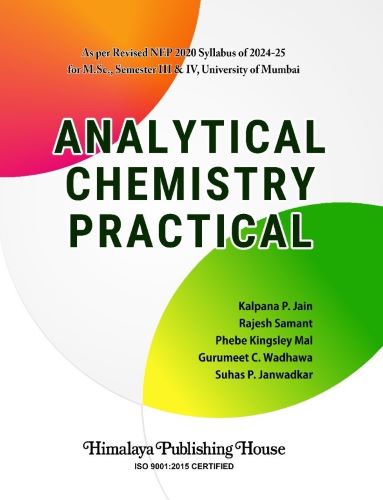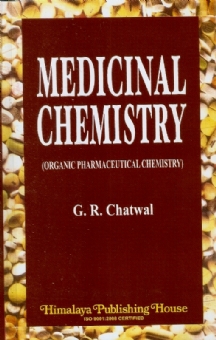This book, M.Sc. II Practical Chemistry Semester III and IV as per New Syllabus NEP 2020, is designed to provide a comprehensive understanding of both theoretical and practical aspects of analytical chemistry, specifically tailored to align with the New Education Policy (NEP) 2020. It aims to equip learners with essential knowledge and skills, encompassing both classical and modern instrumental methods, required for the analysis of diverse samples such as soil, water, and commercial products. Emphasising foundational principles, this book prepares students for critical roles in environmental and industrial chemistry by delivering systematic training in laboratory techniques, sample preparation, and instrumental handling.
Through this book, learners will gain hands-on experience in basic laboratory operations, including non-instrumental and instrumental methods for analysing a variety of samples. It covers all facets of sample preparation and aims to hone the learners’ ability to conduct accurate calculations to generate reliable results. Dedicated sections on soil and water analysis ensure that students understand essential practices, from detecting and quantifying analytes to performing quality assessments on environmental samples. The book also provides an introductory yet thorough exposure to the use of analytical techniques in commercial quality assessment.
Beyond the basics, this book aims to foster an understanding of research methodology, instilling an awareness of the importance of research and its application in problem-solving. Learners will be introduced to identifying research problems, utilising journal articles and digital resources, and developing systematic research plans, bridging theoretical knowledge with experimental implementation.
In essence, M.Sc. II Practical Chemistry as per New Syllabus NEP 2020 seeks to create a solid foundation in practical chemistry. It encourages analytical thinking and provides learners with the tools to apply theory to real-world situations, preparing them to contribute meaningfully in both academic and industrial research environments. This preface serves as an invitation for learners to engage in an immersive journey that blends technical expertise with critical research skills, essential for their future careers in chemistry and beyond.
Contents –
SEMESTER III
ANALYTICAL CHEMISTRY PRACTICAL
Non-instrumental
1. Determination of Calcium by Complexometric Titration with EDTA in the Sample of Milk Powder
2. Determination of SAP Value for a given Oil Sample
3. Determination of Iodine Value for a given Oil Sample
4. Honey Sample: Determination of Total Reducing Sugars before and after Inversion by Cole’s Ferricyanide Method
5. Estimation of Benzoic Acid and Salicylic Acid in Whitfield Ointment
6. Estimation of Fe in Iron Tablets using Titrimetric Method
7. Estimation of Calcium in Ca-pentothenate/Ca-lactate Tablet Instrumental
1. Determination of pKa Value of an Indicator Spectrophotometrically
2. Determination of Amount of Sulphuric Acid, Acetic Acid and Copper Sulphate in a Mixture by Conductometric Titration with Sodium Hydroxide
3. Determination of Percentage Purity of the given Sample of Methylene Blue/Malachite Green
4. Spectrophotometric Determination of pH of a Buffer Solution
5. Determination of Aniline and Ethanolamine in a Mixture of Two in Acetonitrile by Potentiometric Titration
6. Simultaneous Determination of Ti(III) and V(V) Spectrophotometrically by H2O2 Method
ENVIRONMENTAL CHEMISTRY PRACTICAL
Non-instrumental
1. Determination of Organic Carbon in Soil by Walkley-Black Method
2. To Determine the Alkalinity of a given Water Sample
3. To Determine the Salinity of a given Water Sample
4. To Determine the Amount of Sulphate in the given Water Sample by the Benzidine Sulphate Method
5. Determination of Chromium in Water Sample by Least Square Method
6. Estimation of Extractable Calcium in Soil Sample Complexometrically
Instrumental
1. Determination of Potassium in Soil Sample Flame Photometrically by Standard Addition Method
2. Determination of Sodium in Water Sample Flame Photometrically by Calibration Curve Method
3. To Determine the Amount of Mn2+ in the given Water Sample Spectrophotometriclly
4. Determination of Lead in the Water Sample Spectrophotometrically
5. Determination of Available Nitrogen in the Soil or Estimation of Ammonia in Water by Kjeldahl Distillation Assembly (Demo Experiment)
INDUSTRIALLY IMPORTANT MATERIALS PRACTICAL
Non-instrumental
1. Assay of the Commercial Samples as per IP:
(i) Calcium Carbonate
(ii) Magnesium Sulphate
(iii) Glycerine
(iv) Iodine
2. Analysis of Calcium Oxide in Cement (White Cement) Complexometrically
3. Determination of Amount of Acetic Acid in Ear Drops Titrimetrically
4. Preparation of Cold Cream and Vanishing Cream (Demo Experiment)
Instrumental
1. Estimation of Aspirin Content in the Tablet by Conductometric Titration
2. Determination of Phosphate Ion in Detergent Sample Spectrophotometrically
3. Estimation of Iron in Tablet Spectrophotometrically by using 1, 10-phenanthroline
4. Determination of Paracetamol in Tablet Spectrophotometrically
Research Project
SEMESTER IV
Research Project







